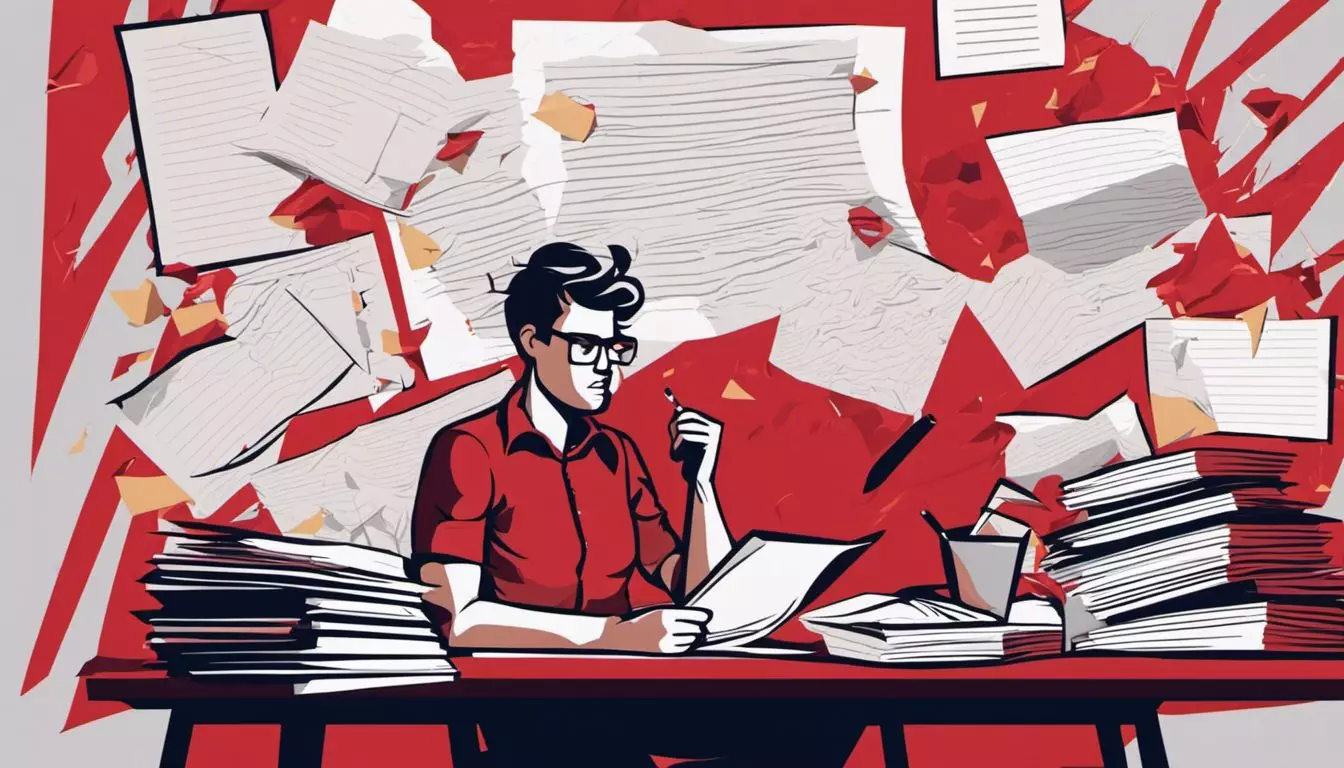The distinct literary tool of onomatopoeia, recognized for its peculiar spelling and captivating sounds, is genuinely enchanting. When adeptly used, it can transform your storyline into a vivid sensory journey, creating striking imagery that heightens your reader’s engagement.
But just what is onomatopoeia? How can you utilize it effectively in your writing? And how do you sidestep common pitfalls while infusing this device into your narrative? If you’re either an aspiring writer or an established author aiming for a spruce-up on your prose, this comprehensive guide is just for you!
Let’s plunge into the world of sound words and explore how they can breathe life into your stories, making them roar, buzz, hiss, or chatter – you pick your favorite onomatopoeic verb!
Key Takeaways
- Onomatopoeia is a literary device that employs sound words to mimic noises in writing.
- Applying onomatopoeia can render your writing more vibrant and engaging, framing vivid images in the reader’s mind.
- Onomatopoeic verbs, nouns, and adjectives all play a crucial role in effective storytelling, enhancing the reader’s experience.
- It’s vital to use onomatopoeia judiciously, opting for words that align with the tone, target audience, and genre of your story.
Understanding Onomatopoeia
Onomatopoeia is a delightful linguistic tool that aids writers in emulating sounds via words. Examples include “crash,” “bang,” or “pop,” which mirror the noises they represent.
Embellishing your writing with these sound words can infuse it with vibrancy, helping to form visuals in your readers’ minds. But remember, the smart application of onomatopoeia is as important as using these sound words. Overutilizing them can lead to unattractive redundancy or a dragging narrative pace.
So, always carefully consider the optimal placement for these effervescent sound words!
The Role of Onomatopoeia in Storytelling
Onomatopoeia shines its transformative role in storytelling through the creation of vivid imagery, enhancing the reader’s experience, and enriching your narrative.
Creating Vivid Imagery
Onomatopoeia breathes life into words and vividly paints images in our minds. For instance, words like “buzz” or “pop” let us do more than just read the sounds – they make us feel as though we’re hearing them, making the story feel tangible and exciting.
Moreover, these sound words can illustrate a development without directly stating it. Say, the word “sizzle” can imply something is hot and cooking, or the word “crash” might indicate something just fell.
With a careful use of onomatopoeia, you can paint a complete picture of a scene with just a few words.
Enhancing Reader’s Experience
Onomatopoeia can enrich a story, turning a black and white narrative into a colorful tapestry teeming with life and feeling. Sounds in real life aren’t just noises – they evoke emotion. A soft hiss, for example, might send a chill down your spine.
But it’s not merely applicable to written narratives. Consider a web design that emits a quiet buzz when the user answers quiz questions correctly or that clicks every time an item is dropped into an online shopping basket. These small sounds contribute to immense feelings, making the digital interaction more fun and realistic.
So, web designers often employ onomatopoeia to foster a better connection with users of any age. In this way, a design becomes a full-fledged experience rather than flat images on a screen.
Ultimately, employing sound words thoughtfully can hold your readers spellbound to your narrative, or keep users engaged with your website or app. So, invest time in selecting the optimal sound words that suit the tone and audience of your piece!
Adding Depth to Narrative
Lastly, onomatopoeia adds depth to a narrative, making a story feel alive rather than just black-and-white words on a page. The appropriate sound word lends the narrative a pulse, enabling the audience to see, hear, and feel the story in their mind. It adds dimensions to your tale, plunges readers deep into your fabricated world, and lets them experience the characters‘ journeys firsthand.
Types of Onomatopoeia

Sound words in the form of verbs, nouns, and adjectives can all be masterfully used as onomatopoeia in a story. By integrating these different types of sound words, you can make your narrative echo with life-like sounds that captivate your readers.
Immerse yourself more in how onomatopoeia can enhance your storytelling experience!
Verbs as Onomatopoeia
Even verbs can serve as onomatopoeia, adding a touch of realism and specificity to your descriptions. By utilizing verbs that mimic sounds, you can ‘show’ rather than ‘tell’ a reader about the unfolding events.
Doing this allows readers to fully experience the scene in their minds, creating a more vivid and engaging reading experience. For instance, instead of saying “The car went fast,” try “The car zoomed past.” The word “zoomed” provides a clear image of speed and motion.
While using verbs as onomatopoeia, it’s vital to select the correct words and ensure they match the tone, target audience, and genre of your narrative. Effectively used onomatopoeic verbs can enhance your storytelling and more completely immerse readers in your narrative universe.
Nouns as Onomatopoeia
Nouns, too, can simulate sounds, helping to create a more vivid aural picture of a scene and enabling readers to imagine and hear the described sound. Words such as “crash,” “splash,” and “buzz” are onomatopoeic nouns that add specificity and verisimilitude to description. Choosing the right sound to represent is vital when using onomatopoeic nouns.
Adjectives as Onomatopoeia
Adjectives also showcase onomatopoeia in writing. For example, “crash” and “bang” can serve as adjectives imitating the actual sounds they represent.
Adjectives like “hum,” which sounds like the sound it represents, can also be used effectively as onomatopoeia. Including adjectives as onomatopoeia in your writing not only add specificity but also enrich the sensory experience of your readers.
Overall, the clever deployment of adjectives to mirror real-life sounds can significantly amplify your readers’ engagement.
Examples of Effective Use of Onomatopoeia

Onomatopoeia is indeed a power-packed literary device that can inject life into your narrative by describing sounds uniquely and engagingly. Here are a few examples showcasing its adept integration in storytelling:
- Bang! The door slammed shut, startling everyone in the room.
- The sizzle of bacon filled the air, making everyone’s mouths water in anticipation.
- The engine roared as the race car zoomed down the track.
- The baby giggled with delight as she played with her noisy rattle.
- As the storm approached, thunder rumbled in the distance, sending shivers down everyone’s spine.
When to Use Onomatopoeia in Writing
Onomatopoeia can play a diverse range of roles in writing. Be it drafting a creative piece, adding some spark to your descriptions, or creating authentic dialogue, knowing when and how to use onomatopoeia is critical.
With strategic use of sound words, you can infuse your narrative with life, engaging readers at an entirely new level.
Writing a Creative Piece
When crafting a creative story, using onomatopoeia can add a layer of depth and ingenuity to your writing. Onomatopoeic verbs, nouns, and adjectives can bring the sounds in your narrative alive. However, remember to use onomatopoeia sparingly and in congruence with the tone, target age group, and genre of your story.
Writing encapsulates more than just narrating STORIES; it also means evoking SENSES. By adopting onomatopoeia, you indulge in ‘showing’ the happenings, letting readers dive deep into the scene. So, liberate your creativity and let it play with sound effects in your writing!
Adding Pizzazz to Descriptions
Descriptions in text can significantly benefit from a sprinkle of onomatopoeia. By emulating real-life sounds, you can create a full-fledged sensory journey for your readers. For instance, replacing a mundane “the door closed” with a vibrant “the door slammed shut” not only adds energy and excitement to the scene but provides a more accurate image.
Onomatopoeia comes in particularly handy when describing intense emotions or action sequences. But remember, moderation is key. Overloading your narrative with sound words can disrupt its flow and push it towards cliché territory.
Creating Authentic Dialogue
Incorporating onomatopoeia into dialogue is a critical tool for creating authentic and realistic conversations. It makes character discussions more specific and lifelike, enhancing the reader’s experience.
Remember, dialogue is more than an exchange of words. It involves tonality, pace, and, yes – sounds. But just as in other instances, overdoing onomatopoeia can make your text seem artificial. Striking a balance is crucial to ensure your readers are transported into the world of your characters without a hitch.
Using Onomatopoeia in Different Genres

Whether you’re crafting a children’s book or creating complex realms in a fiction novel, onomatopoeia is a versatile tool that can add an extra layer of dimension and authenticity to your narration.
Let’s explore how this sound-based technique enhances different genres and engages readers with its immersive qualities.
Children’s Books
In children’s literature, onomatopoeia plays an integral role in engaging young readers. The vibrant sound words such as “kapow,” “crash,” and “pow” create vivid imagery in the minds of the children, enriching their reading experience.
By incorporating these sound effects into the narrative, the author can animate characters and actions, making the reading session more fun for the young ones.
Fiction Books
Onomatopoeic words significantly heighten the intensity of action or suspense scenes in fiction books. For instance, imagine narrating a car chase scene – the screeching tires, the roaring engines, the whizzing bullets; the influence of the apt sound words can make all the difference.
However, navigating the nuanced usage of onomatopoeia in fiction is critical. While some readers appreciate the added depth of sound effects, others may find it overwhelming.
Common Pitfalls to Avoid When Using Onomatopoeia
While onomatopoeia can enrich your storytelling, it also comes with its fair share of pitfalls. Here are some common errors to dodge while using this literary device:
- Overusing Onomatopoeia: An excessive usage of sound words can distract your reader. Like any other flavor, keep it sparing for maximum impact.
- Relying on clichés: Experiment with unique and creative ways to describe sounds. Instead of the same old “boom” or “crash,” find fresh alternatives that can surprise and captivate your reader.
- Disrupting the Flow: The improper insertion of onomatopoeia can negatively affect the flow of your storytelling. Seamlessly integrate it into the narrative for a natural read.
- Neglecting Other Description Techniques: While onomatopoeia is a potent device, do not neglect other elements of descriptive prose. Sensory details and vivid language form an essential part of the whole experience.
- Ignoring Context: Context drives meaning. An onomatopoeic word may change its effect based on where and how it’s used. Make sure it fits naturally into your story’s setting, theme, and characters.
- Forgetting about Tone: The overall tone of your story must harmonize with the onomatopoeic words you choose. They should also match the mood you aim to evoke in that particular scene or sentence.
- Lack of Variety: Don’t limit yourself to a specific type of sound word. Dabble in verbs, nouns, adjectives, and even comic-book-style interjections for a dynamic and varied reading experience.
- Not Editing for Clarity: After incorporating onomatopoeia into your prose, take time to review it for clarity. Ensure that the intended sound effects are easily understandable and visualizable for your readers.
Conclusion

In summation, Onomatopoeia is a powerful storytelling device that brings your writing alive. By employing onomatopoetic words such as “crash,” “bang,” and “zap,” you are able to construct vivid imageries, enhance the reader’s experience, and add depth to your narration.
It’s crucial to choose the right sound words for your target audience and story’s genre, and to judiciously sprinkle onomatopoeia to avoid clichés or redundancy. With these pointers, you’ll be set to effectively incorporate onomatopoeia into your writing, rendering it more engaging for your audience.
So, let the melody of onomatopoeia echo throughout your stories – your readers will surely be enthralled!
FAQs
1. What is onomatopoeia in writing?
Onomatopoeia is a literary technique that employs sound-mimicking words to portray noises in a narrative.
2. Can you give me examples of onomatopoeia?
Certainly, words like “buzzed”, “dripped”, “clangs” are prime examples of onomatopoeia. They enable the reader to easily imagine animal sounds or the noises of nature.
3. How can I use onomatopoeia when writing a story?
You can utilize this tool to narrate character actions or provide setting details. It assists in adding aural impact to your narrative, making your piece of writing come alive.
4. Does using too much Onomatopoeia leads to confusion for readers?
Yes, the excessive use of onomatopoeia may lead to repetitive patterns that can confuse readers rather than provide clarity.
5. Are there any tools for checking if my usage of onomatopoeic words is correct?
Yes, grammar checkers like ProWritingAid can help assure that your usage aligns with established writing conventions and rules.
6. Where else could we usually see the application of onomatopoeic Words besides stories?
Besides being utilized by fiction writers in novels and short stories, these sound words are also popular in comic book dialogues or even newspaper headlines.

